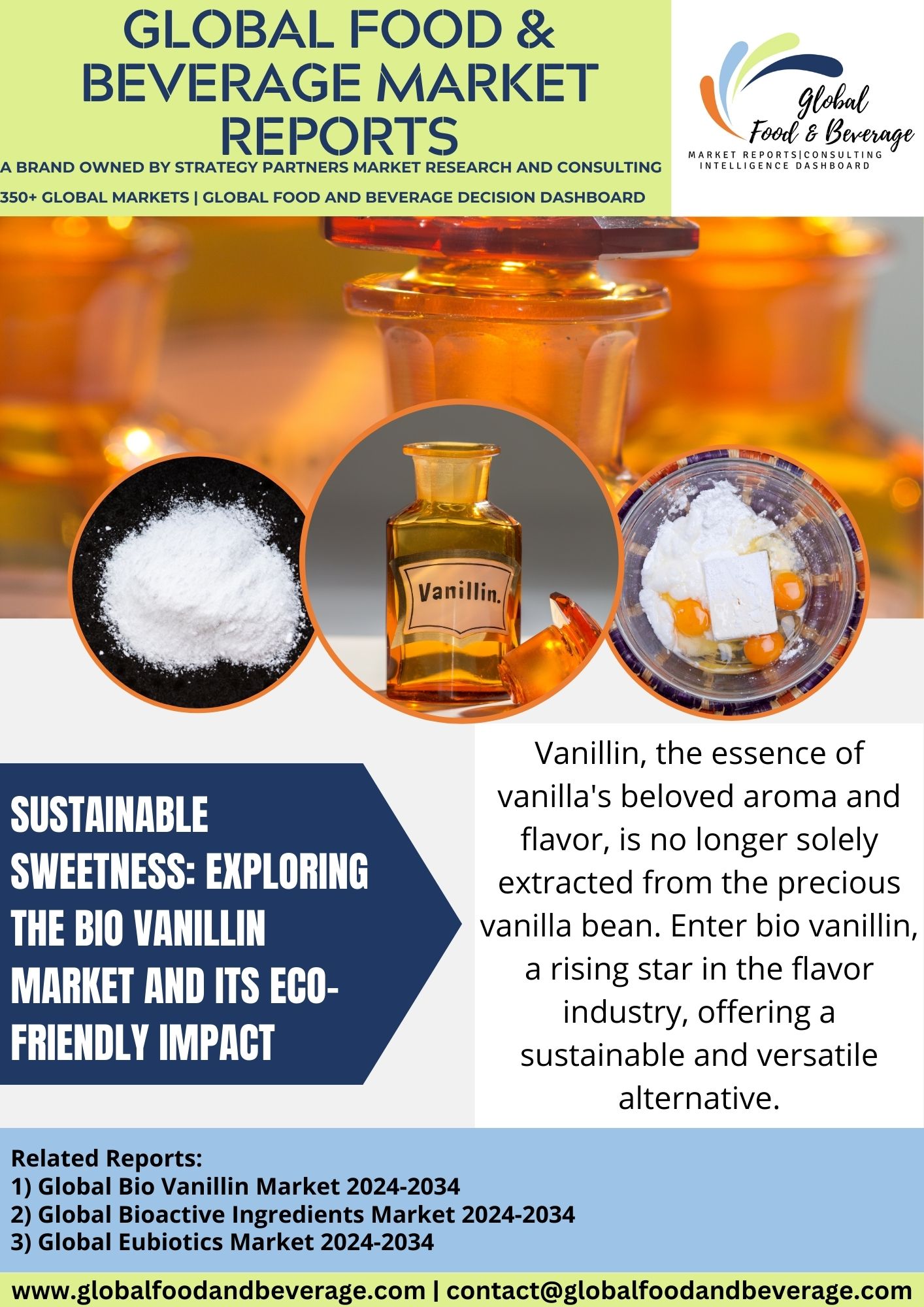Sustainable Sweetness: Exploring the Bio Vanillin Market and its Eco-Friendly Impact
Bio vanillin represents a sustainable and eco-friendly alternative to synthetic vanillin, which is a key component of vanilla flavor widely used in the food and beverage industry. Traditionally, synthetic vanillin has been produced from petrochemical sources, raising environmental concerns and sustainability issues. In response to these challenges, bio vanillin is derived from natural sources through innovative and eco-conscious processes.

One common method for producing bio vanillin involves the fermentation of natural precursors, such as ferulic acid found in plant cell walls. Microorganisms like bacteria or yeast are employed to convert these precursors into vanillin, mimicking the natural biosynthetic pathways. This process provides a more sustainable and renewable source of vanillin compared to the conventional methods that rely on fossil fuels.
Another approach to bio vanillin production utilizes biotechnology and genetic engineering. By introducing specific genes into microbial hosts or plant cells, researchers can enhance the production of vanillin precursors, ultimately increasing the yield of bio vanillin. This method allows for the customization of vanillin production and optimization of the entire process for greater efficiency.
The adoption of bio vanillin aligns with the growing consumer demand for natural and sustainably sourced ingredients in food products. As consumers become more conscious of their environmental impact, the food industry is seeking alternatives that offer the same high-quality flavor while reducing reliance on non-renewable resources and minimizing the carbon footprint associated with traditional vanillin production.
Beyond its sustainability benefits, bio vanillin maintains the authentic and high-quality flavor profile associated with natural vanilla. It is virtually indistinguishable from synthetic vanillin in terms of taste and aroma, making it a seamless replacement in a wide range of food and beverage applications. This versatility allows food manufacturers to meet consumer expectations for natural and clean-label products without compromising on taste.
As the demand for sustainable and natural ingredients continues to rise, bio vanillin stands at the forefront of innovation in flavor production. Its development represents a step towards a more environmentally conscious and ethically sourced food industry. With ongoing advancements in biotechnology and fermentation processes, bio vanillin is likely to play a pivotal role in shaping the future of flavoring agents, providing a sustainable solution that meets the evolving preferences of both manufacturers and consumers.
ADVANCEMENTS
Bio vanillin, a synthetic alternative to natural vanilla, has witnessed significant advancements that address both the growing demand for sustainable flavorings and the desire to reduce reliance on traditional vanilla cultivation. One notable breakthrough is the development of bio vanillin through innovative biotechnological processes. Microbial fermentation and bioconversion techniques allow the production of vanillin from renewable feedstocks such as ferulic acid, lignin, or even agricultural waste, reducing dependence on traditional vanilla bean cultivation and contributing to a more sustainable supply chain.
The utilization of enzyme technologies has enhanced the efficiency and yield of bio vanillin production. Enzymes catalyze specific reactions in the bioconversion process, leading to higher purity and quality of the final product. This approach aligns with the broader industry trend toward cleaner and more environmentally friendly production methods.
Advancements in metabolic engineering and synthetic biology have enabled the optimization of microbial strains for vanillin production. By manipulating the metabolic pathways of microorganisms like yeast or bacteria, researchers can enhance their ability to convert precursor compounds into bio vanillin, resulting in higher yields and cost-effective production.
Improved downstream processing techniques contribute to the scalability and commercial viability of bio vanillin production. Extraction, purification, and formulation methods have undergone refinements, ensuring that the final product meets the quality standards expected in the food and beverage industry.
The rise of consumer preferences for natural and sustainable ingredients has driven the adoption of bio vanillin by food and flavoring manufacturers. The ability to offer a cost-effective and environmentally friendly alternative to natural vanilla positions bio vanillin as a valuable ingredient in various applications, from food and beverages to cosmetics and pharmaceuticals.
CHALLENGES
Bio vanillin, a natural alternative to synthetic vanilla flavoring derived from petrochemicals, faces several challenges in its production, market acceptance, and scalability. One significant challenge is the cost of production. Bio vanillin is often more expensive to produce than its synthetic counterpart due to the complexities of the extraction or biosynthesis processes. Developing cost-effective production methods is crucial to making bio vanillin competitive in the flavoring market.
Supply chain considerations and the availability of raw materials pose challenges for bio vanillin production. The primary sources for bio vanillin include vanilla orchids, lignin, or ferulic acid from plant sources. Ensuring a stable and sustainable supply of these raw materials requires addressing agricultural challenges, such as climate sensitivity, crop diseases, and fluctuations in yield.
The Bio Vanillin market faces another challenge w. While there is a growing demand for natural and sustainable food ingredients, synthetic vanillin has historically dominated the market due to its lower cost. Convincing manufacturers and consumers to shift to bio vanillin may require marketing efforts, education about its sustainability benefits, and possibly regulatory incentives.
Regulatory considerations add complexity to the adoption of bio vanillin. Meeting stringent food safety and quality standards, obtaining regulatory approvals, and ensuring compliance with labeling requirements demand significant investments and collaboration with regulatory bodies.
Scalability and production capacity represent challenges for the widespread adoption of bio vanillin. As demand increases, the industry must overcome technical and logistical hurdles to scale up production without compromising quality and sustainability.
CONCLUSION
Bio vanillin stands as a sustainable and innovative alternative in the world of flavorings. Derived from natural sources like vanilla beans or lignin, it embodies a commitment to environmental consciousness and reduced dependence on synthetic production. Beyond its aromatic contribution to the food and fragrance industries, bio vanillin represents a harmonious fusion of science and sustainability. As consumer preferences align with clean labels and eco-friendly choices, the future of bio vanillin shines brightly. Its potential to redefine the flavor landscape showcases a flavorful journey where authenticity, environmental responsibility, and culinary creativity converge in a promising and aromatic symphony.
